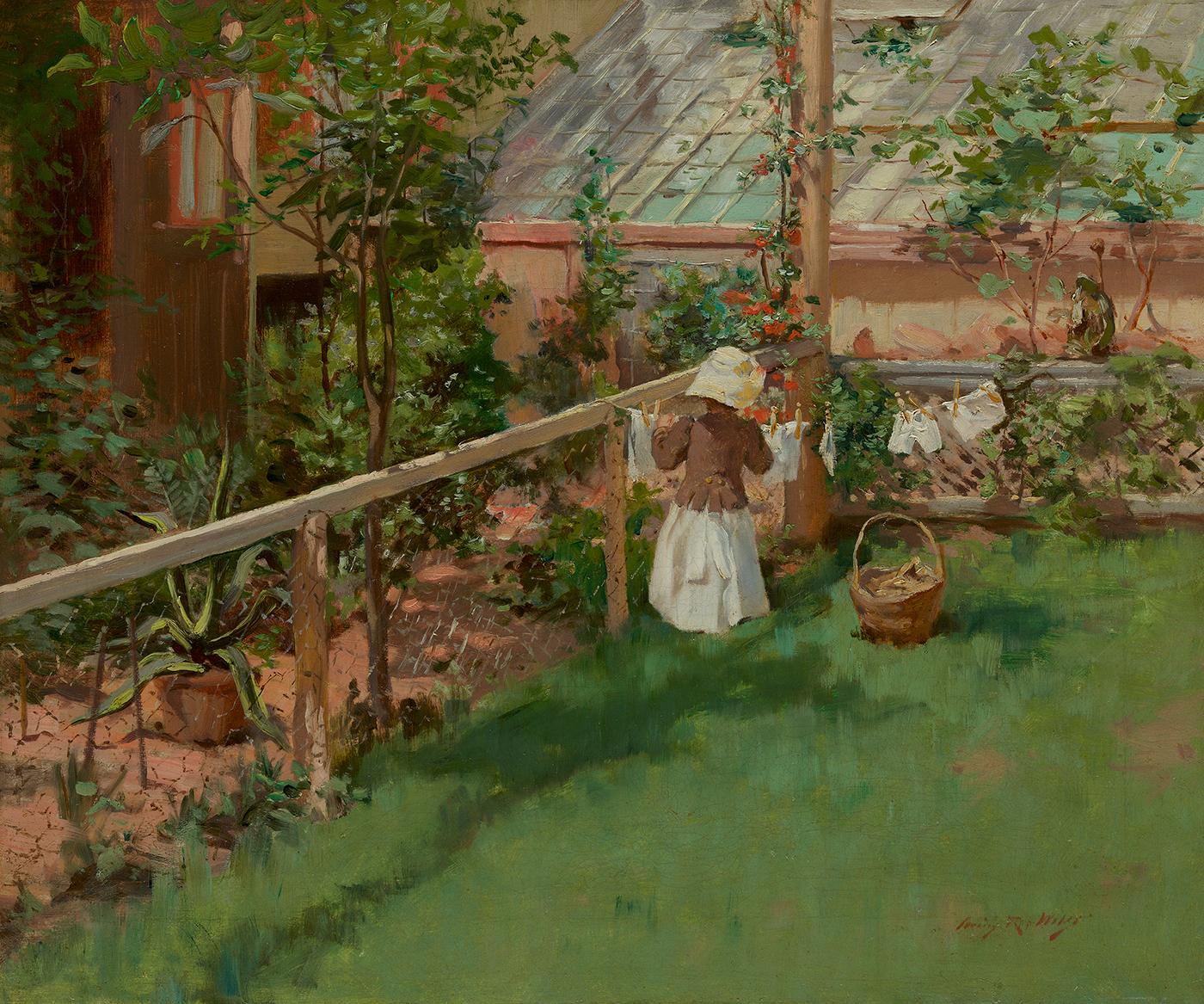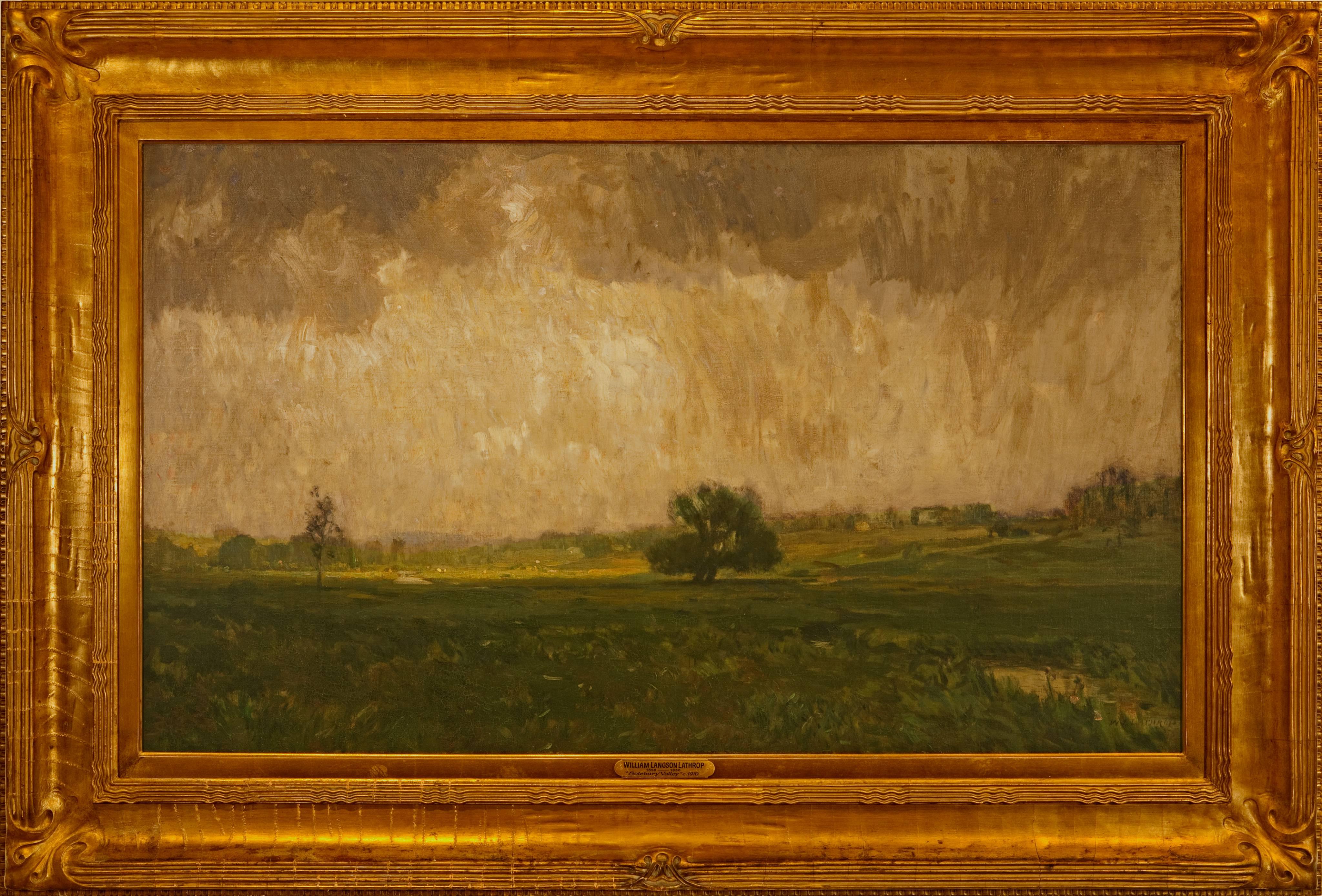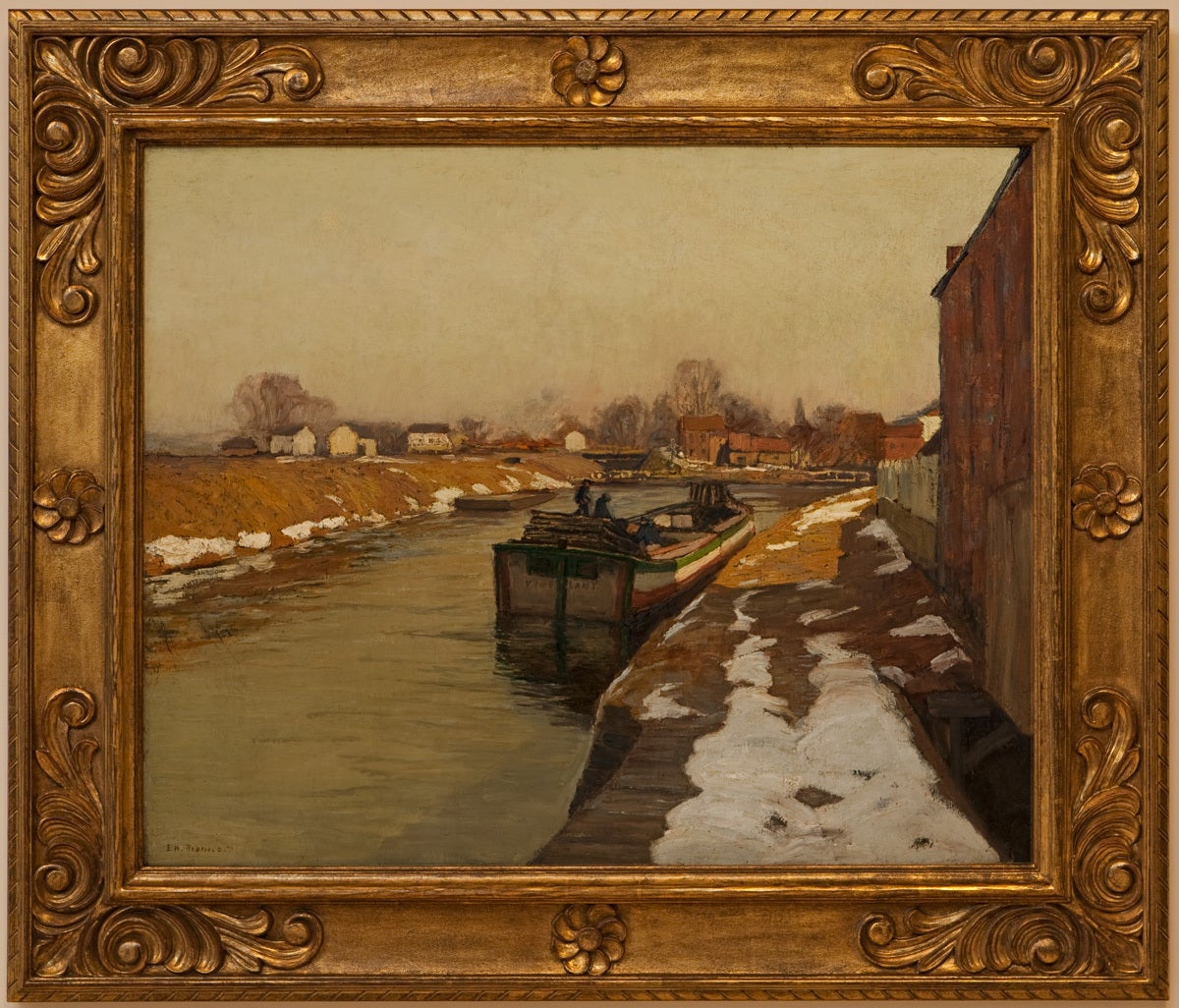Want more images or videos?
Request additional images or videos from the seller
Arthur Clifton GoodwinHigh Bridge, New York
About the Item
Signed lower right.
Bio:
A painter especially known for street and waterfront scenes of Boston, Arthur Clifton Goodwin did work that captured the subtle nuances of light and color, creating a harmony between and the natural environment. His style reflected American Impressionism, although his subject matter was not typically rural. He preferred painting Boston and particularly scenes where the city met the natural landscape, such as piers, bridges, or the Boston statehouse. His "T" wharf series, representing the pier where boats of largely Portuguese and Italian origin would dock, were quite well known.
Goodwin was born in Portsmouth, New Hampshire, and was raised in Chelsea Massachusetts. He did not begin painting until the age of thirty and became a self-taught Impressionist and also a follower of the Ashcan School led by Robert Henri. After painting in Boston in both oil and pastel for a twenty-year period, Goodwin gained the recognition of famous art figures including John Singer Sargent, Mrs. Jack Gardner, and John T. Spaulding. Childe Hassam was quoted as describing Goodwin as "the greatest painter in Boston."
However, Goodwin's erratic lifestyle frequently cost him patrons as did the inconsistency of his pricing of his paintings.
In 1921, he left Boston for New York City and had a studio on Washington Square where he "developed a reputation as one of the few American Impressionists to prefer urban subjects" (Spanierman) including bridges, parks and avenues. He and his wife then lived in Chatham, New York where he painted many landscapes. In 1929, he returned to Boston and resumed his Bohemian lifestyle. That same year he died suddenly, found in his home by friends with his trunk fully packed and lying beside a steamship ticket to France. Credit: askart
- Creator:Arthur Clifton Goodwin (1866-1929, American)
- Dimensions:Height: 25 in (63.5 cm)Width: 30 in (76.2 cm)Depth: 3 in (7.62 cm)
- Medium:
- Movement & Style:
- Period:
- Condition:
- Gallery Location:Saratoga Springs, NY
- Reference Number:1stDibs: LU17026347572
About the Seller
4.2
Vetted Seller
These experienced sellers undergo a comprehensive evaluation by our team of in-house experts.
Established in 1992
1stDibs seller since 2015
30 sales on 1stDibs
Typical response time: 19 hours
- ShippingRetrieving quote...Ships From: Saratoga Springs, NY
- Return PolicyA return for this item may be initiated within 3 days of delivery.
More From This SellerView All
- The Red House, Cornwall, ConnecticutBy Charles Warren EatonLocated in Saratoga Springs, NYSigned lower left. Born in Albany, New York, Charles Eaton became a Tonalist landscape painter much influenced by George Inness. His intimate, moody landscapes were known for subdued golden-brown hues and muted tonal harmonies, and the subject was often the landscape in late autumn, evening time, or winter. These paintings were groundbreaking because they were relatively small in scale and intimate countryside views, which was a departure from the generally popular panoramic, romanticized views of Hudson River School painters. In 1879, he enrolled at the National Academy of Design in New York City and then studied figure painting at the Art Students League with J. Carroll Beckwith. He became a close associate with Leonard Ochtman and Ben Foster...Category
Mid-20th Century American Impressionist Landscape Paintings
MaterialsOil, Canvas
- New York HarborBy Guy WigginsLocated in Saratoga Springs, NYSigned lower right. Guy Carleton Wiggins adopted the bright palette and lively brushwork of the impressionist movement, and is best known for his New York City snow scenes...Category
Mid-20th Century American Impressionist Landscape Paintings
MaterialsOil, Canvas
- Wall Street New YorkBy Gail Sherman CorbettLocated in Saratoga Springs, NYSigned lower right.Category
Mid-20th Century American Impressionist Figurative Paintings
MaterialsOil, Canvas
- Autumn LandscapeBy William Merritt PostLocated in Saratoga Springs, NYSigned lower left. "Scholars continually rediscover competent American artists who enjoyed successful careers at the turn of the century, but whose legacy has been lost over time. One of these, William Merritt Post, was a tonalist landscape painter often associated with the Barbizon school and the early New England Impressionists...Category
Early 20th Century American Impressionist Landscape Paintings
MaterialsOil, Board
- Gramacy Army Plaza Brooklyn NYBy Johann Berthelsen, 1883-1972Located in Saratoga Springs, NYSigned lower right. Following his graduation, he toured the United States and Canada as lead baritone for the Grand Opera Company, after which he taught voice - first as his alma matter...Category
Mid-20th Century American Impressionist Landscape Paintings
MaterialsOil, Board
- Mango Trees, Rio Piedras, Puerto RicoBy Reynolds BealLocated in Saratoga Springs, NYSigned lower left and dated 1921. About the artist: From an affluent and artistic family, Reynolds Beal and his younger brother Gifford both made careers in art. Beal was born in ...Category
1920s Impressionist Landscape Paintings
MaterialsOil, Canvas
You May Also Like
- At the ClotheslineBy Irving Ramsey WilesLocated in New York, NYSigned lower right: Irving R. WilesCategory
Late 19th Century American Impressionist Landscape Paintings
MaterialsCanvas, Oil
- "Alley Fiends"By John R. GrabachLocated in Lambertville, NJJim’s of Lambertville is proud to offer this artwork by: John R. Grabach (1886 - 1981) John Grabach was a highly regarded New Jersey artist, teacher, and author of the classic text...Category
1930s American Impressionist Landscape Paintings
MaterialsCanvas, Oil
- "Forest Strongholds"By John F. CarlsonLocated in Lambertville, NJSigned lower right. Complemented by a hand carved and gilt frame. Exhibited at the National Academy of Design, 1928Category
20th Century American Impressionist Landscape Paintings
MaterialsCanvas, Oil
- "Solebury Valley"By William Langson LathropLocated in Lambertville, NJSigned lower right. Complemented by a period frame. William L. Lathrop (1859-1938) Deemed “Father of the New Hope Art Colony”, William Langson Lathrop was born in Warren, Illinois. He was largely self-taught, having only studied briefly with William Merritt Chase in 1887, at the Art Students League. Lathrop first moved east in the early 1880s, and took a job at the Photoengraving Company in New York City. While there, he befriended a fellow employee, Henry B. Snell. The two men became lifelong friends and ultimately, both would be considered central figures among the New Hope Art Colony. Lathrop's early years as an artist were ones of continuing struggle. His efforts to break through in the New York art scene seemed futile, so he scraped enough money together to travel to Europe with Henry Snell in1888. There he met and married an English girl, Annie Burt. Upon returning to New York, he tried his hand at etching, making tools from old saw blades...Category
1910s American Impressionist Landscape Paintings
MaterialsCanvas, Oil
- Winter MoonlightBy George William SotterLocated in Lambertville, NJsigned lower rightCategory
1910s American Impressionist Landscape Paintings
MaterialsCanvas, Oil
- "The Canal"By Edward Willis RedfieldLocated in Lambertville, NJJim’s of Lambertville is proud to offer this artwork. Signed lower left. Complemented by a hand carved and gilt frame. Illustrated in "Edward Redfield: Just Values and Fine Seeing" by Constance Kimmerle and the Pennsylvania Academy of the Fine Arts's Exhibition of Paintings by Edward Redfield (April 17 to May 16, 1909) brochure Edward Willis Redfield (1869 - 1965) Edward W. Redfield was born in Bridgeville, Delaware, moving to Philadelphia as a young child. Determined to be an artist from an early age, he studied at the Spring Garden Institute and the Franklin Institute before entering the Pennsylvania Academy from 1887 to 1889, where he studied under Thomas Anshutz, James Kelly, and Thomas Hovenden. Along with his friend and fellow artist, Robert Henri, he traveled abroad in 1889 and studied at the Academie Julian in Paris under William Bouguereau and Tony Robert-Fleury. While in France, Redfield met Elise Deligant, the daughter of an innkeeper, and married in London in 1893. Upon his return to the United States, Redfield and his wife settled in Glenside, Pennsylvania. He remained there until 1898, at which time he moved his family to Center Bridge, a town several miles north of New Hope along the Delaware River. Redfield painted prolifically in the 1890s but it was not until the beginning of the twentieth century that he would develop the bold impressionist style that defined his career. As Redfield’s international reputation spread, many young artists gravitated to New Hope as he was a great inspiration and an iconic role model. Edward Redfield remained in Center Bridge throughout his long life, fathering his six children there. Around 1905 and 1906, Redfield’s style was coming into its own, employing thick vigorous brush strokes tightly woven and layered with a multitude of colors. These large plein-air canvases define the essence of Pennsylvania Impressionism. By 1907, Redfield had perfected his craft and, from this point forward, was creating some of his finest work. Redfield would once again return to France where he painted a small but important body of work between 1907 and 1908. While there, he received an Honorable Mention from the Paris Salon for one of these canvases. In 1910 he was awarded a Gold Medal at the prestigious Buenos Aires Exposition and at the Panama-Pacific Exposition of 1915 in San Francisco, an entire gallery was dedicated for twenty-one of his paintings. Since Redfield painted for Exhibition with the intent to win medals, his best effort often went into his larger paintings. Although he also painted many fine smaller pictures, virtually all of his works were of major award-winning canvas sizes of 38x50 or 50x56 inches. If one were to assign a period of Redfield’s work that was representative of his “best period”, it would have to be from 1907 to 1925. Although he was capable of creating masterpieces though the late 1940s, his style fully matured by 1907 and most work from then through the early twenties was of consistently high quality. In the later 1920s and through the 1930s and 1940s, he was like most other great artists, creating some paintings that were superb examples and others that were of more ordinary quality. Redfield earned an international reputation at a young age, known for accurately recording nature with his canvases and painting virtually all of his work outdoors; Redfield was one of a rare breed. He was regarded as the pioneer of impressionist winter landscape painting in America, having few if any equals. Redfield spent summers in Maine, first at Boothbay Harbor and beginning in the 1920s, on Monhegan Island. There he painted colorful marine and coastal scenes as well as the island’s landscape and fishing shacks. He remained active painting and making Windsor style furniture...Category
Early 1900s American Impressionist Landscape Paintings
MaterialsCanvas, Oil





